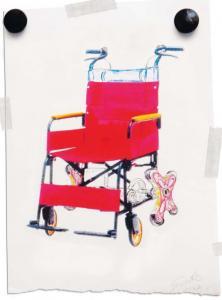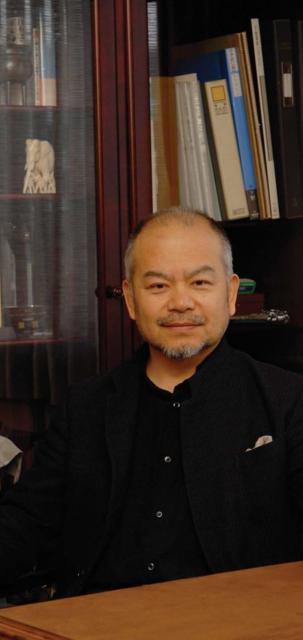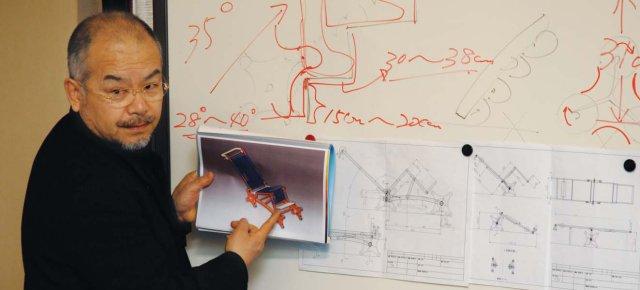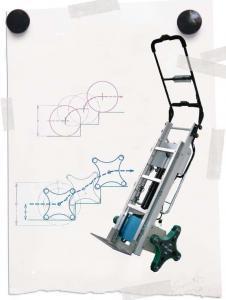Reinventing the Wheel

By Anna Kitanaka
Inventing treasures
Excellence in two areas of natural ability and an obsessive tendency seem to be a regular formula for the personality of an inventor. A deep-rooted sense of mechanics on the one hand, combined with a burning creativity on the other, is common to a number of the world's most celebrated inventors-add to this natural mix an obsession with making things and we have it, a simple flowchart for a highly productive innovator. Often these three ingredients of inventors manifest themselves in childhood-Galileo apparently made his own toys as a child while the boyhood Alexander Graham Bell reportedly used to experiment with his pet dog's vocal faculties by pressing on his pet's voice box.
Many successful innovators have also been very artistic-unsurprising given the requirement for technical drawings in the making of prototypes: of this sort, Leonardo da Vinci is the most obvious archetype. Japanese inventor, Mitsuo Sawada, fits the formula outlined above. Visiting him at his Shikoku headquarters, he told us that as a child he was always going to art classes and constantly making things and his boyhood ambition was to become a carpenter. However, after traveling the world during his twenties, he became hooked on jewelry and design.  Since then he has channeled his creative energies into the design and production of his own impressive range of jewelry. His backlog of awards and prizes includes recognition by the Japan Jewelry Association and at the International Pearl Design Contest. In 1993 he started to market his own jewelry in the form of the 'Mitsuo Collection,' known and respected for its innovative and striking design-in particular Sawada is celebrated for his natural and cosmic motifs.
Since then he has channeled his creative energies into the design and production of his own impressive range of jewelry. His backlog of awards and prizes includes recognition by the Japan Jewelry Association and at the International Pearl Design Contest. In 1993 he started to market his own jewelry in the form of the 'Mitsuo Collection,' known and respected for its innovative and striking design-in particular Sawada is celebrated for his natural and cosmic motifs.
Remarkable about Sawada's achievement is his constant output-he has folders of drawings and designs and it is instantly clear that he is the type of artist who never really switches off. His office, surrounded by the quiet sublimity of the Takamatsu mountains, is filled with interesting artifacts and collector's items of diverse styles from Greco-Roman to modern Japanese. However, on opening the door to one room we are greeted by the sight of what appears to be stacks of luggage of different shapes and sizes. Sawada grins excitedly, we are about to learn about another of his inventions, spawned in the trail of his creative endeavors and life as a jewelry dealer.
Deals and wheels
In his career as both a designer and a dealer, Sawada would often have to carry around heavy baggage full of precious stones, metals and other weighty items when participating in exhibitions around the country. He encountered difficulty when hauling the luggage up the stairs-the wheels were fine for flat surfaces but during his travels by train his luggage let him down when going up and down the stairs on the way to the platform. Complaining about this to a friend over a beer, the friend challenged him to create something that could handle the stairs as well.
 Mitsuo Sawada: Designer and Inventor
Mitsuo Sawada: Designer and Inventor
Sawada instantly set to work, cutting out strips of cardboard to somehow solve the problem. He quickly learned that the task was not going to be easy, different surfaces suited different types of wheel and the weight of the luggage had to be factored into the design. However, he settled on a basic design of a four-pronged wheel-with a small wheel on the end of each prong-that would allow the carrier to pull their case up or down stairs without having to lift it by hand. By fixing the wheels at four points along a curved square the case can negotiate each stair by using the arch as a lever to turn itself onto the next wheel.
Thrilled to have won his bet and having built a fully functional model of his idea, Sawada saw the commercial potential of his creation-he named it Dancoro (dan meaning 'level' and coro meaning to 'roll'). To insure that if he mass-produced the item it would be viable internationally, Sawada armed himself with a tape measure and traveled the world measuring stairs in cities across the globe, from London to Hawaii. He discovered that all stairs are made according to the natural lift of a human leg, roughly 15-20 centimeters in height, and that the average breadth of the stairs is roughly 28 centimeters, easily accommodating the average foot. Thus, Sawada calculated that with an external diameter of 31 centimeters, his invention could climb any step in the world up to a maximum step height of 25 centimeters. By perfecting the angles of the design, height and curvature, Sawada developed the product to the point where it works with total smoothness when pulled up or pushed down stairs, without any irritating and potentially damaging banging.
Sensing the commercial potential of Dancoro, Sawada was aware of the importance of patenting his invention. Within just over a year staring from April 2000, Sawada patented Dancoro in nine countries: Japan, the US, Germany, France, Canada, China, South Korea, Singapore and Taiwan. The patent protects the curve of the bars connecting the small wheels together-the four curved sides gives the products its unique and enchanting appearance as a circular square. For variety, Sawada has also created a triangular model, although however many angles the wheel has, they are all covered by the patent.
 Mitsuo Sawada
Mitsuo Sawada
Escalating the business
Having protected his invention, Sawada did anything but rest. He has been active in attaining two goals. Firstly, to expand the scope of the product, and secondly, to turn it into a profitable enterprise. In pursuit of the first of these objectives Sawada has carefully honed the original prototype and developed a number of unique uses for it beyond attaching it to conventional luggage. For example, in response to request from Toshiba, he has successfully built an electronically operated trolley that can carry up to 250 kilograms for use in office buildings, warehouses or residences. Other similar models are able to carry other heavy loads such as gas cylinders and palettes. The nickel-hydrogen battery enables the user to easily charge the trolley by simply plugging it into the mains. Other completed projects for the product wheel include sun-loungers and shopping trolleys.
Among his ideas and designs for future Dancoro contraptions are wheelchairs allowing the occupant to be safely wheeled up and downstairs without the need for a stair-lift, and yet another plan is in place for a designer-style version of the wheel that wouldn't look out of place attached to a piece of luggage made by Louis Vuitton or another luxury brand-in this there is clear evidence of Sawada's day job.
In terms of his second objective, Dancoro has had moderate market success in Japan. Focusing on his core business of jewelry, Sawada has sold the sales and distribution license to various operators and from this he also collects royalties. The product is manufactured in China and the basic model retails at ¥19,800. However, the electronic version and larger size adaptations are sold by different outlets for him. The company Art Medicines sell the manual shopping trolley adaptation whilst retail outfit Hokuei sell the electric version for carrying gas cylinders and many of the original products are sold online.
 Dancoro: in action, going up and down stairs in a smooth continuous motion
Dancoro: in action, going up and down stairs in a smooth continuous motion
Although Sawada made a proud profit out of the license sale and the royalties, his main satisfaction comes from the fact that "people are actually using something that I created-I can see it is useful and for an inventor that is the happiest thing." However, being extremely busy with his other company- Mitsuo Collection- he has reluctantly decided to put his entire Dancoro business, including the patents, up for sale. Eight years on and most of the patents have at least another twelve years left on them until they expire. He explained, "My main business is jewelry design and I want to focus on that again-also I am very happy living here in Shikoku, I don't want to have to move to Tokyo and deal with the practicalities of the Dancoro business, much as I cherish the experience the invention has given me." At 58 years old, Sawada remains youthful but wants to finish his career as he dreamed of when he started, as an important and successful jewelry designer.
Constant innovation
Yet despite his desire to sell up, Sawada is still very excited about the possibilities for Dancoro and delights in giving us demonstrations up and down the stairs of his office. He mentions particularly the potential for the invention to be used in medical services, "Dancoro could easily enable oxygen tanks to be used in the home, or be adapted for emergency stretchers." As an oxygen tank is required to be carried upright, this model allows for the cylinders (with a weight of up to 80 kilograms) to be hauled vertically.
Commercially, he also thinks that in Europe the original product has massive potential for use in older buildings that are too old to be equipped with elevators or stair-lifts and stresses that the product is gentle to the stairs too. Most recently, Sawada tells us he has been exploring the possibility of a vehicle fitted with a Dancoro wheel at the front. By changing the size of the wheel, it will be capable of surmounting obstacles or climbing staircase-like terrains, and a possible use could be for moon vehicles. Ultimately, Sawada is keen to see Dancoro take on a life of its own, being useful to society on a global scale. Consequently he will likely be remembered not only as a stellar jewelry designer, but also as the man who reinvented the wheel.JI
Contact details

SAWADA CO. LTD.
2350-5 Takamatsu-cho, Takamatsu-city,
Kagawa, 761-0104 Japan
Tel: 087-841-5151
Fax: 087-843-2412
sawada@dancoro.com
www.dancoro.com





